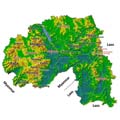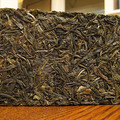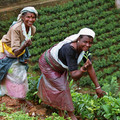Puerh History - Pu-erh.Net
„Yunnan Tea Company standardized the trade number for Pu Erh Tea in 1976 for the purpose of export. Each bingcha has 4 digits: the first 2 digits indicate the manufacturing year, the third digit indicates the leaf grade, the last digit indicates the tea factory (e.g. Kun-Ming 1, Meng-Hai 2, Xia-Guan 3, Pu Erh 4). The loose-leaf tea has 5 digits with the third and fourth indicating the class level of raw materials. Examples of early trade numbers for Puerh Tea are 7452, 7562, 7572, 75671, 76563.“

Quotes Tags: Pu-erh, Tea production, Cake, China
- Discussion: 0 comments
- Write a comment
Teas - Pu-erh
2015 Spring Man Nuo Gu Shu Mao Cha 50g
 0 reviews
0 reviewsMan Nuo ancient tea gardens, at an altitude of 1266 meters. The tea trees are really...
Lao ManE 2013 autumn
 1 review
1 reviewThe LaoManE rules over this autumn teas. In this village you may find really bitter tea...
Sheng 2013 Blind Tasting Set
 1 review
1 reviewBuy only teas you like not teas you think you like! This is a blind tasting set of...
2012 Mangfei "Da Ye Chun" Early Spring
 1 review
1 reviewThis high quality old tree tea cake come from a small shop in Yongde. Using early...
2014 Chawangpu "Lao Yu" Xiao Bing Cha
 1 review
1 reviewLao Yu (老妪) : old woman Material for this cake came from a small Bulang...
1997 CNNP Big Red Mark Raw Puerh Cake
 1 review
1 reviewThis cake is called "Da Hong Yin" or Big Red Mark. It's a blend from Banna area tea...
Quotes - Pu-erh
„Hui Gan 回甘, Hui Tian 回甜, Sheng Jin 生津, & Hui Yun 回韻…In literally term, Hui Gan, sometimes referred to as Hui Wei, is to reflect sweetly on a past event. Borrowing from the term 'to reflect', Hui Gan in tea is, simply put, a reflection on the sweetness of the tea - when one drink the tea, when the tea slides through the cavity of the mouth into the throat, there comes, after a short while, a sweetness that rises up from the throat. This sweetness is sometimes accompanied with a fragrance. Do not keep the upper and lower mouth pressed together when sipping tea, but create a cavity instead by lowering the jaw. Let the tea wash over the entire inside of the mouth, and then direct the tea to slide from the sides of the jaw into the throat. While holding the empty cavity, breathe out instead of in after you swallow the tea, there is warmth in the breath accompanied by a fragrance, and the same fragrance that rises up from the throat. This is Hui Gan.“
Quotes Tags: Pu-erh, China, Tea infusion, Experiencing tea
Video - Pu-erh
Theme
Teas
2006 Haiwan Organic Pasha Tea Brick 500g
 1 review
1 reviewThis brick was stored in Kunming since 2006, it was made by using the best raw materials Haiwan Tea Factory...
Lao ManE 2013 autumn
 1 review
1 reviewThe LaoManE rules over this autumn teas. In this village you may find really bitter tea and also sweet teas...
2005 Boyou TF 0507M Ripe Puerh Cake
 1 review
1 reviewBoyou was founded in 2005, now is one of the factories which still adhere to the strictest sanitary...
Tea by region
We will help you with tea selection.
Do you like quality loose tea?
We will help you to find the right one for you. Be inspired by tea ratings of other tea lovers. Rating stars could help you.


Review your cup of tea.
Review the tea you are drinking and help other tea lovers to find the right cup of tea.






 Shops
Shops Share on Facebook
Share on Facebook


























